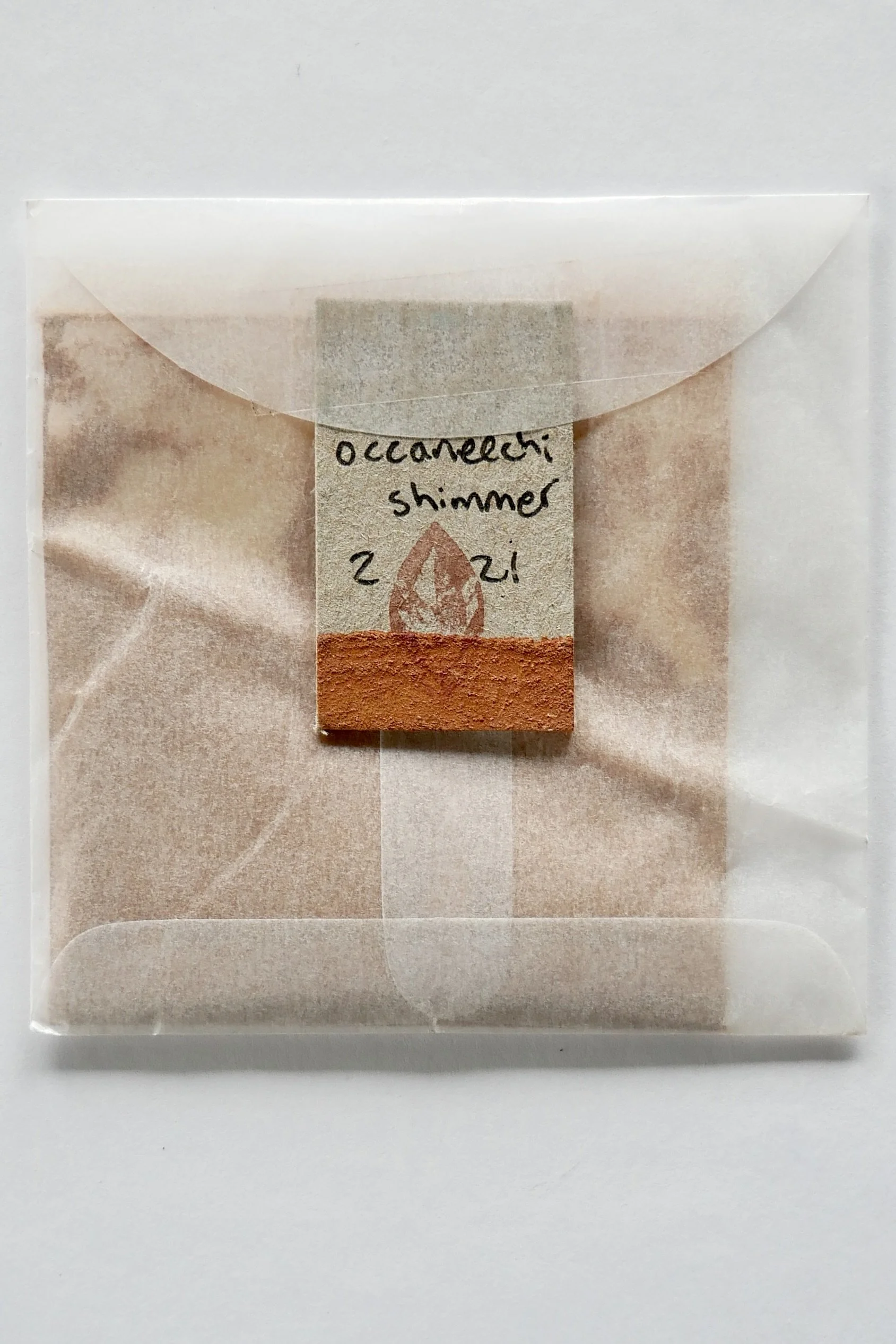occaneechi shimmer : february ‘21
Occaneechi Shimmer was gathered by artist Kelly Moody on the edges of flooded Occaneechi lands in the state of Virginia near the John Kerr dam.The dam, completed in 1947, caused the waters of the Roanoke River to rise and cover Occoneechee Island, the four-mile-long island which is the ancestral homelands of one group of Occaneechi people, and a center for trade in the region. Geologically, the area is a plateau known as the Piedmont, or “foothills,” due to its location at the base of the Blue Ridge Mountains. The red soils there are a soil division known as “ultisols,” also called “red clay soils.” Typically, ultisols occur in humid temperate or tropical regions, and contain no calcium carbonate.
This pigment is an iron oxide ochre with a high mica content, thus the shimmer, which is especially visible in strong light. Iron oxides are the most stable, easy-to-work-with pigments, and will never fade.
contributor : kelly moody
Kelly Moody grew up in the Piedmont region of southern Virginia in tobacco and muscadine country on the traditional lands of the Occaneechi, Meherrian and Saponi. After a B.A. in Philosophy and five years of organic farming and intensive study with several herbalists and ecologists, Kelly hit the road. For the last seven years she has been studying the land, plants and place by being out in the field all across the Western U.S. This past year has found her especially engaged in learning about wild-tending practices, which has included long stretches of time spent in backcountry.
Kelly is the founder of The Ground Shots Project, a creative ethnobotanical research and storytelling project which features in-depth botanical write-ups and The Ground Shots Podcast — interviews with artists, ecologists, herbalists, farmers and more. She writes about her travels on the Of Sedge and Salt blog. Both projects and links to the podcast can be found at www.ofsedgeandsalt.com. You can also support Kelly/the podcast through www.patreon.com.
Photo from Kelly Moody’s instagram feed @goldenberries
Photo from visitalamance.com
Photos from the Acres of Ancestry website acresofancestry.org
22% donation recipient : Occaneechi Band of the Saponi Nation/Acres of Ancestry Initiative and Black Agrarian Fund
The Occaneechi Band of the Saponi Nation — OBSN for short — is a small Indian community located primarily in the old settlement of Little Texas, Pleasant Grove Township, Alamance County, North Carolina. The OBSN community is a lineal descendant of the Saponi and related Indians who occupied the Piedmont of North Carolina and Virginia in pre-contact times.
The Occaneechi Homeland Preservation Project was launched in 2002 with the goal of buying back a portion of OBSN ancestral lands in the “Little Texas” community of NE Alamance County. For the first time in 250 years, the Occaneechi own land again as a Tribe, to be used for tribal offices and economic development for the tribal community. On this small tract of rural land, purchased in 2004, the Occaneechi have begun a legacy for their children: 25 acres which will include permanent ceremonial grounds, Tribal orchards, a reconstructed 1701 Occaneechi Village and an 1880’s era farm, educational trails, and a Tribal museum. (text from website: www.osbn.org.)
The Acres of Ancestry Initiative/Black Agrarian Fund works for "collective liberation through the preservation of Black agrarian custodial landownership, ecological stewardship, and food and fiber economies in the South." The Initiative is a self-sustaining collaboration to preserve a value paradigm anchored in collective land venture, spirit-culture reclamation, and ecological harmony. Channeling the collective spirit of the Freedom Quilting Bee, (a textile cooperative founded by Black women agrarian artisans in Alberta, Alabama in 1966), the [initiative] re-centers ecocultural traditions in collaboration with rural communities throughout the Black Belt region.(text from www.acresofancestry.org)





